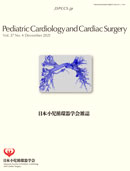Volume 37, Issue 4
Displaying 1-15 of 15 articles from this issue
- |<
- <
- 1
- >
- >|
Preface
-
2021Volume 37Issue 4 Pages 253-254
Published: December 01, 2021
Released on J-STAGE: August 31, 2022
Download PDF (145K)
Review
-
2021Volume 37Issue 4 Pages 255-264
Published: December 01, 2021
Released on J-STAGE: August 31, 2022
Download PDF (814K) -
2021Volume 37Issue 4 Pages 265-276
Published: December 01, 2021
Released on J-STAGE: August 31, 2022
Download PDF (3677K) -
2021Volume 37Issue 4 Pages 277-282
Published: December 01, 2021
Released on J-STAGE: August 31, 2022
Download PDF (1420K) -
2021Volume 37Issue 4 Pages 283-294
Published: December 01, 2021
Released on J-STAGE: August 31, 2022
Download PDF (3053K) -
2021Volume 37Issue 4 Pages 295-306
Published: December 01, 2021
Released on J-STAGE: August 31, 2022
Download PDF (7102K)
Case Report
-
2021Volume 37Issue 4 Pages 307-311
Published: December 01, 2021
Released on J-STAGE: August 31, 2022
Download PDF (4635K) -
2021Volume 37Issue 4 Pages 312-317
Published: December 01, 2021
Released on J-STAGE: August 31, 2022
Download PDF (1596K) -
2021Volume 37Issue 4 Pages 320-328
Published: December 01, 2021
Released on J-STAGE: August 31, 2022
Download PDF (6013K)
Editorial Comment
-
2021Volume 37Issue 4 Pages 318-319
Published: December 01, 2021
Released on J-STAGE: August 31, 2022
Download PDF (1962K)
Series: Training the next Generation
-
2021Volume 37Issue 4 Pages 329-331
Published: December 01, 2021
Released on J-STAGE: August 31, 2022
Download PDF (192K) -
2021Volume 37Issue 4 Pages 332-334
Published: December 01, 2021
Released on J-STAGE: August 31, 2022
Download PDF (2892K) -
2021Volume 37Issue 4 Pages 335-336
Published: December 01, 2021
Released on J-STAGE: August 31, 2022
Download PDF (143K) -
2021Volume 37Issue 4 Pages 337-339
Published: December 01, 2021
Released on J-STAGE: August 31, 2022
Download PDF (1138K) -
2021Volume 37Issue 4 Pages 340-342
Published: December 01, 2021
Released on J-STAGE: August 31, 2022
Download PDF (483K)
- |<
- <
- 1
- >
- >|
